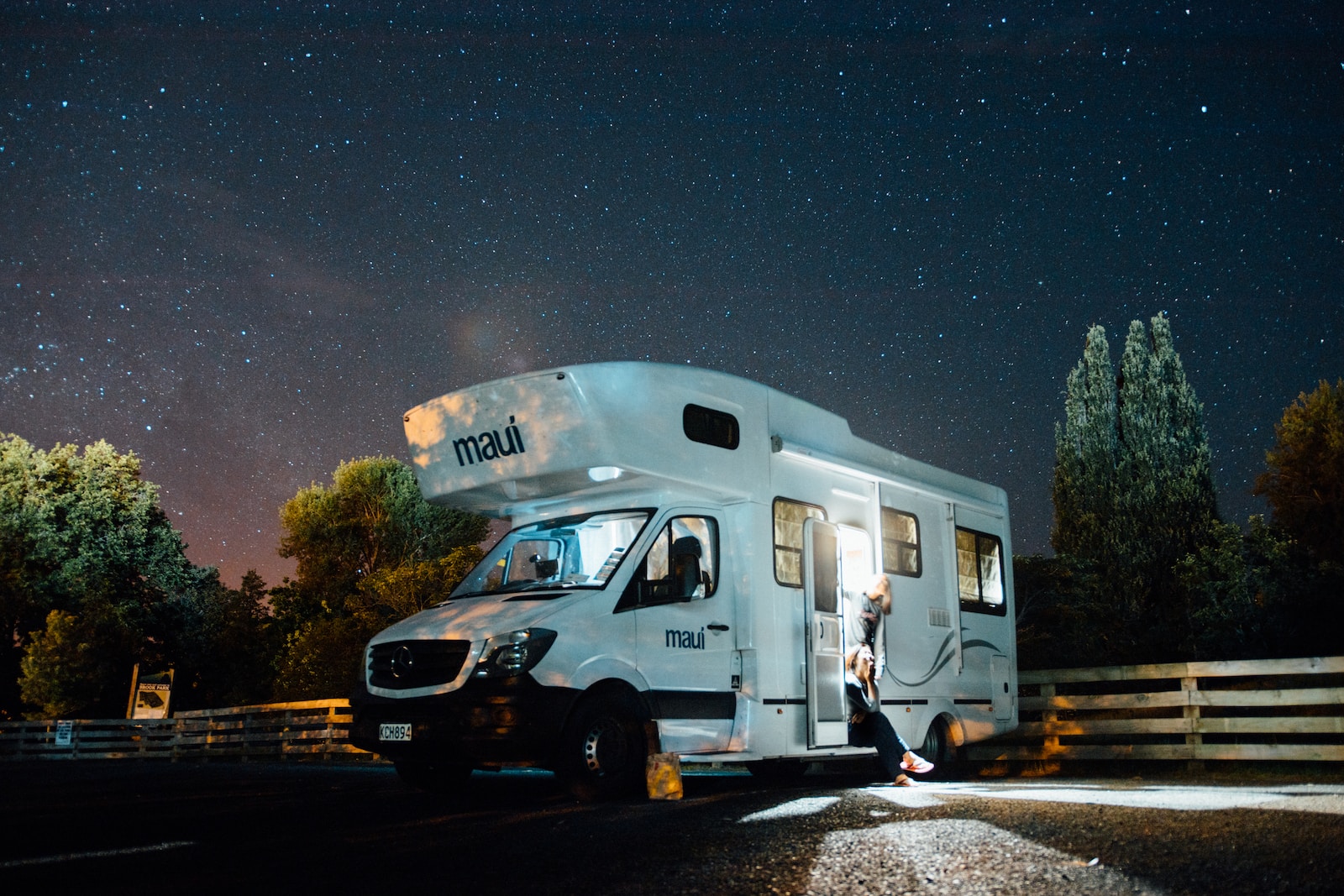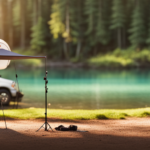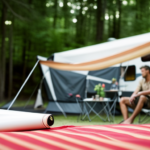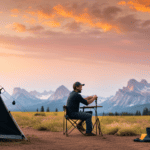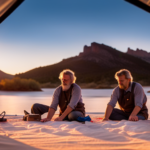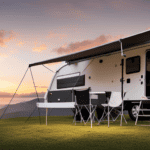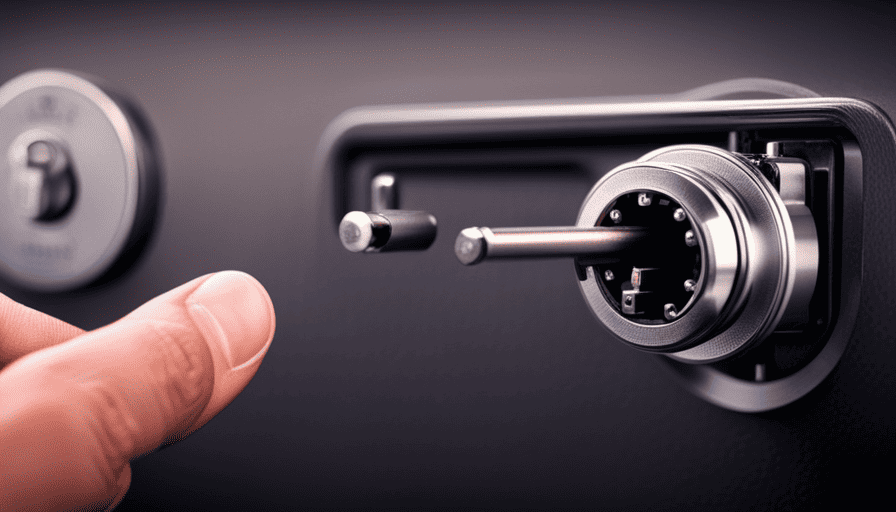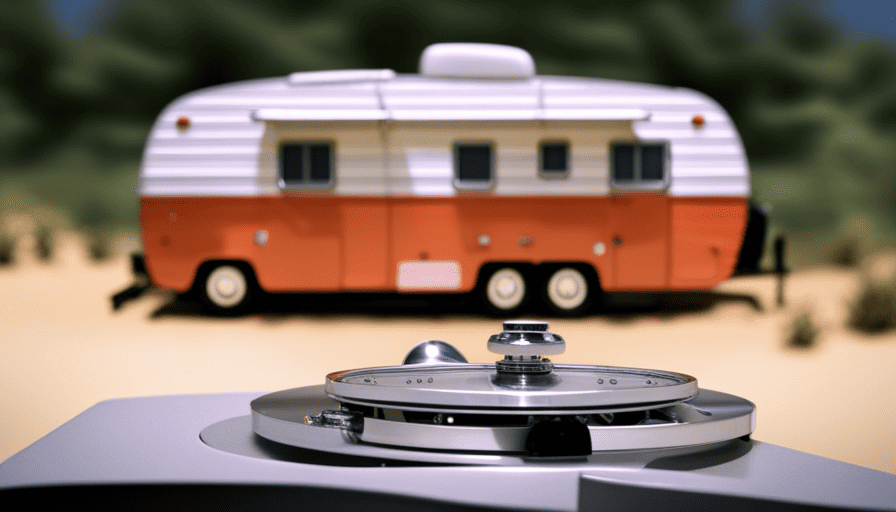Experiencing the beauty of nature is greatly enhanced by the addition of a camper awning, which offers essential shade and protection from the elements.
As the saying goes, ‘A camper awning is a home away from home.’ So, if you’re ready to embark on your next adventure and open up your camper awning, you’ve come to the right place.
In this article, I will guide you through the step-by-step process of opening your camper awning, ensuring that you have a smooth and hassle-free experience. From familiarizing yourself with the awning components to testing its stability and functionality, I’ll provide you with all the practical knowledge you need to know.
So, let’s get started and make sure you’re fully prepared to enjoy the benefits of your open camper awning.
Key Takeaways
- Choose the right time and place to open your awning, considering weather conditions, awning size, shade, and privacy.
- Clear the area and secure your camper before opening the awning.
- Extend the awning arms evenly and maintain regular maintenance.
- Adjust the height and angle of the awning for optimal shade and protection.
Familiarize Yourself with the Awning Components
Get ready to embark on an exciting camping adventure as you familiarize yourself with all the incredible components of your camper awning! Before you can open your awning, it’s important to understand its various parts and how they work together.
Let’s start with an awning components overview. The main components of a camper awning include the awning fabric, roller tube, arms, and support legs. The awning fabric is the material that provides shade and protection from the elements. The roller tube is responsible for rolling and unrolling the fabric. The arms, also known as rafter arms, support the fabric and keep it taut. Lastly, the support legs provide stability and support to the awning when it’s fully extended.
Knowing the different awning components will help you troubleshoot common awning issues. For example, if the fabric is not rolling properly, it could be due to a problem with the roller tube. Similarly, if the arms are not extending or retracting smoothly, there may be an issue with the arm mechanism. By familiarizing yourself with these components, you can easily identify and fix any problems that may arise.
Now that you have a good understanding of the awning components, let’s move on to choosing the right time and place to open your awning.
Choose the Right Time and Place to Open Your Awning
Find the perfect moment and location to unfurl your outdoor haven, ensuring that you have a delightful space to relax and soak up the surroundings. When it comes to opening your camper awning, timing and positioning are crucial for a successful experience. Here are some tips to help you choose the right time and place:
-
Ideal weather conditions: Before opening your awning, check the weather forecast. It’s best to choose a day with mild temperatures and calm winds. Avoid opening it during strong winds or storms, as it can damage the awning and put your safety at risk.
-
Choosing the right awning size: Make sure you have the correct awning size for your camper. Measure the length of the side of your camper where you plan to install the awning and select a corresponding size. A properly fitted awning will provide better shade and protection.
-
Shade and privacy: Look for a spot that offers ample shade and privacy. Avoid areas with direct sunlight, as it can cause the awning fabric to fade and deteriorate over time. Additionally, consider any nearby obstructions such as trees or buildings that may limit the awning’s full extension.
-
Ground conditions: Find a level and stable surface to set up your awning. Avoid uneven or soft ground that could cause the awning to tilt or sink. This will ensure a secure and sturdy installation.
With the ideal weather conditions and the right awning size, you’re ready to create a cozy outdoor haven. Secure your camper and remove any obstacles, preparing for the next steps in opening your awning.
Secure Your Camper and Remove Any Obstacles
Ensure that your camper is tightly secured and any potential obstacles are cleared away, allowing for a smooth and obstacle-free experience. Before opening your camper awning, it’s essential to remove any obstacles in the surrounding area. Look for low-hanging tree branches, rocks, or any other objects that could potentially obstruct the awning’s extension. Clearing the area will prevent any damage to your awning and ensure a safe environment for you and your fellow campers.
Next, make sure your camper is securely stabilized. Use leveling blocks or stabilizing jacks to ensure it’s level and stable. This will prevent any unwanted movement while extending the awning and keep it securely in place.
Additionally, check the security of your camper’s awning arms. Ensure they’re properly locked and in the correct position before attempting to extend the awning. This step is crucial for the safe and successful opening of your camper awning.
By removing obstacles and ensuring camper security, you’re ready to move on to the next step: extending the awning arms. This will allow you to fully enjoy the shade and protection provided by your camper awning.
Extend the Awning Arms
Extend your arms in a confident motion, giving your camper the gift of shade and a comfortable outdoor space. To properly extend the awning arms, follow these steps:
-
Check for any obstructions: Before extending the arms, make sure there aren’t any obstacles in the way that could prevent the awning from fully extending. Clear away any branches or debris that might impede the process.
-
Unlock the arms: Find the locking mechanism on each arm and release it. This will allow the arms to move freely during the extension process.
-
Extend the arms evenly: Gently pull the arms outwards, ensuring that you extend them evenly on both sides. Keep a steady grip to avoid any sudden movements that could cause damage.
Awning maintenance is crucial to ensure its longevity. Regularly inspect the arms for signs of wear or damage, such as rust or bent components. Lubricate any moving parts to prevent them from sticking or becoming difficult to extend.
Troubleshooting common awning issues may involve checking the tension of the arms, adjusting the alignment, or tightening loose screws. If you encounter any problems, refer to your camper’s manual or consult a professional for assistance.
Now that you’ve extended the awning arms, let’s move on to the next step: adjusting the awning height and angle.
Adjust the Awning Height and Angle
To get the perfect amount of shade and maximize your outdoor comfort, you’ll want to adjust the height and angle of your awning. Did you know that studies have shown that adjusting the angle of your awning can reduce solar heat gain by up to 65%?
Adjusting the awning height is a simple process that can be done with just a few easy steps. Start by locating the height adjustment knobs on each awning arm. Loosen the knobs and raise or lower the arms to your desired height. Once you’ve adjusted the height, tighten the knobs to secure the arms in place.
Choosing the right awning angle is also important for optimal shade and protection. The angle of the awning can be adjusted by using the angle adjustment knobs located on each arm. Loosen the knobs and tilt the awning until you achieve the desired angle. This’ll allow you to block the sun and create a comfortable outdoor space.
Now that you’ve adjusted the height and angle of your awning, it’s time to secure the awning fabric. This’ll ensure that your awning stays in place even in windy conditions.
Secure the Awning Fabric
Now it’s time to make sure your awning fabric is securely fastened to keep it in place during windy conditions. Proper awning maintenance is crucial to ensure the longevity of your camper awning.
To care for the awning fabric, start by inspecting it for any signs of wear or damage. Look for tears, loose stitching, or any areas that may need repair. If you find any issues, it’s important to address them promptly to prevent further damage.
Next, check the tension of the awning fabric. The fabric should be taut but not overly tight. Adjust the tension by using the tension knobs or straps provided with your awning. These can be tightened or loosened to achieve the desired tension. Be sure to follow the manufacturer’s instructions for your specific awning model.
To further secure the awning fabric, use the provided stakes or anchoring system. This will help prevent the fabric from flapping or billowing in the wind. Make sure the stakes are securely fastened to the ground or the anchoring system is properly installed.
Lastly, inspect the awning fabric periodically throughout your camping trips. Check for any signs of wear or damage and make any necessary repairs. By taking care of your awning fabric, you can ensure a longer lifespan and better performance.
Now that your awning fabric is securely fastened, it’s time to test the awning for stability and functionality without compromising its integrity.
Test the Awning for Stability and Functionality
After securely fastening the awning fabric, how stable and functional is it? To ensure that your camper awning is in optimal condition, it’s crucial to test its stability and functionality. Here are some test techniques and troubleshooting tips to help you with this task:
-
Check the tension: Start by verifying if the awning fabric is taut. Adjust the tension if needed, as a loose awning may be prone to flapping in the wind, leading to potential damage.
-
Test the extension and retraction: Extend and retract the awning multiple times to ensure smooth operation. If you encounter any resistance or jerking motions, investigate the cause and address it promptly.
-
Inspect the arms and joints: Thoroughly examine the arms and joints for any signs of wear, such as rust or loose connections. Replace or repair any damaged components to maintain the awning’s stability.
-
Assess water resistance: Spray water onto the awning fabric to check its water resistance. If you notice water pooling or seeping through, consider applying a waterproofing treatment.
By carefully testing your camper awning’s stability and functionality using these techniques, you can identify any issues and address them proactively. Taking proper care of your awning is essential to ensure its longevity and continued enjoyment on your camping adventures.
Take Proper Care of Your Awning
Ensure your outdoor shelter remains in pristine condition by implementing proper maintenance techniques. Taking proper care of your awning is essential to prolong its lifespan and prevent any damage. Here are some awning maintenance tips to keep in mind.
Firstly, choose the right awning fabric. Look for materials that are durable, resistant to fading, and easy to clean. Popular options include acrylic, vinyl, and polyester fabrics. Consider your specific needs and climate conditions when making your selection.
Regularly clean your awning to remove dirt, debris, and stains. Use a soft brush, mild soap, and water to gently scrub the fabric. Avoid using harsh chemicals or abrasive cleaners that can damage the fabric.
Inspect your awning periodically for signs of wear and tear. Check for loose threads, tears, or any structural issues. Addressing these problems early on can prevent further damage and costly repairs.
Proper maintenance is key to ensuring the longevity of your awning. By selecting the right fabric and implementing regular cleaning and inspections, you can keep your awning in excellent condition for years to come.
Now, let’s move on to the next section and learn how to safely close and store your awning.
Safely Close and Store Your Awning
To safely close and store your outdoor shelter, follow these simple steps to ensure the longevity of your awning.
First, start by cleaning the awning fabric. Use a mild soap and water solution to gently scrub away any dirt or stains. Rinse thoroughly and allow the fabric to dry completely before proceeding. Cleaning the fabric regularly will prevent the buildup of dirt and debris, which can cause damage over time.
Next, inspect your awning for any common problems. Look for tears or holes in the fabric, loose or broken hardware, or any signs of wear and tear. If you notice any issues, it’s important to address them before closing and storing your awning. Repair any tears or replace damaged hardware to prevent further damage.
Once your awning is clean and in good condition, it’s time to close and store it. Follow the manufacturer’s instructions for your specific awning model, as the process may vary. Generally, you’ll need to retract the awning by rolling it up tightly. Secure it with any straps or fasteners provided. Store your awning in a clean, dry place away from harsh weather conditions.
By properly closing and storing your awning, you can enjoy the benefits of your open camper awning for years to come.
Enjoy the Benefits of Your Open Camper Awning
Get ready to experience the amazing advantages of having your outdoor shelter extended! Owning a camper awning brings numerous benefits that can greatly enhance your camping experience. Not only does it provide shade and protection from the elements, but it also creates a cozy and comfortable outdoor living space.
One of the key benefits of owning an awning is the extra space it provides. With the awning extended, you can set up chairs, tables, and even a small outdoor kitchen, allowing you to enjoy meals and activities outside without being exposed to the sun or rain. It also gives you the option to entertain guests or simply relax and enjoy the scenery.
To maximize your awning usage, here are a few tips to keep in mind. Firstly, always make sure to secure the awning properly to avoid any accidents or damage caused by unexpected winds. Additionally, consider investing in additional accessories such as awning lights or curtains to add ambiance and privacy to your outdoor space. Lastly, remember to clean and maintain your awning regularly to prolong its lifespan and keep it in optimal condition.
The benefits of owning a camper awning are undeniable. It provides you with a versatile and comfortable outdoor living space, allowing you to make the most of your camping adventures. By following these tips, you can maximize your awning usage and create unforgettable memories in the great outdoors.
Frequently Asked Questions
What are some common mistakes to avoid when opening a camper awning?
When opening a camper awning, it’s important to avoid common mistakes that can lead to damage or accidents. Here are some tips and tricks to keep in mind.
First, make sure to check the weather conditions before opening the awning to avoid strong winds or rain.
Additionally, always secure the awning properly to prevent it from collapsing unexpectedly.
Lastly, be cautious of any obstacles or low-hanging branches that could obstruct the awning’s extension.
By following these simple guidelines, you can ensure a smooth and safe awning opening experience.
How long does it typically take to open a camper awning?
On average, it typically takes about 5-10 minutes to open a camper awning. However, this time can vary depending on various factors such as the type of awning and the experience of the person opening it.
To troubleshoot common issues when opening a camper awning, check for any obstructions or debris that may be preventing it from fully extending. Additionally, to properly store a camper awning when not in use, make sure it’s clean and dry before rolling it up tightly and securing it with straps or bungee cords.
Can I open my camper awning on a windy day?
On a windy day, it’s important to take precautions before opening your camper awning. Strong winds can damage the awning or even cause it to collapse. Before opening, check the weather forecast for wind speeds. If it’s too windy, it’s best to avoid opening the awning altogether. Alternatively, you can consider using alternative awning options, such as a windbreak or a retractable sunshade, that are designed to withstand windy conditions.
Is it necessary to clean the awning fabric before opening it?
Before opening my camper awning, it’s necessary to clean the fabric for optimal performance and longevity. Cleaning the awning fabric removes dirt, debris, and stains that can accumulate over time. This not only improves the appearance but also helps to prevent mold and mildew growth. By regularly cleaning the fabric, I can ensure that it remains in good condition and extends the lifespan of my awning.
Are there any safety precautions I should take while opening my camper awning?
When opening my camper awning, there are a few safety precautions I always take. First, I make sure the area around the awning is clear of any obstacles or hazards.
I also check that the awning is securely locked before extending it fully. It’s important to use the proper technique and follow the manufacturer’s instructions to prevent any accidents or damage.
By being cautious and using the right approach, I can safely enjoy my camper awning.
What is the Maximum Size Awning that Can Be Installed on a 32 Ft Camper?
The square footage of a 32 ft camper determines the maximum size of an awning that can be installed. Typically, awnings are proportional to the size of the camper, providing shade and shelter. For a 32 ft camper, it’s advisable to select an awning that complements the dimensions without overpowering the space.
Conclusion
Well, there you have it! Opening your camper awning may seem like a daunting task, but with the right knowledge and preparation, it can be a breeze.
Remember to familiarize yourself with the components, choose the right time and place, secure your camper, and extend the awning arms. Adjust the height and angle to your preference, and don’t forget to test for stability and functionality.
Take proper care of your awning to ensure its longevity, and when you’re done, safely close and store it.
Now, imagine your camper awning as a colorful canopy, providing shade and shelter, as you relax and enjoy the great outdoors. Happy camping!


